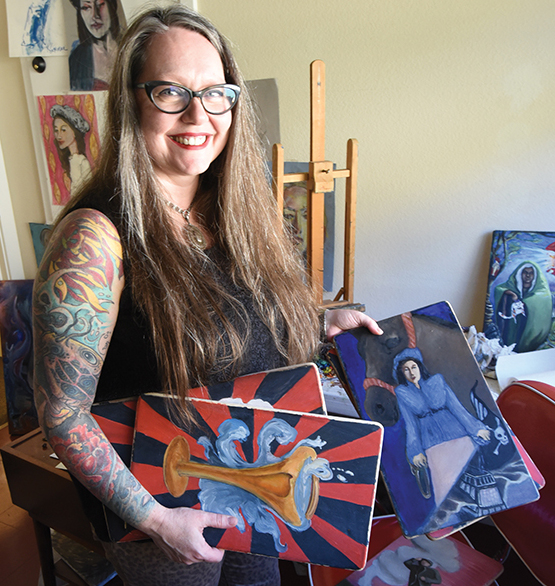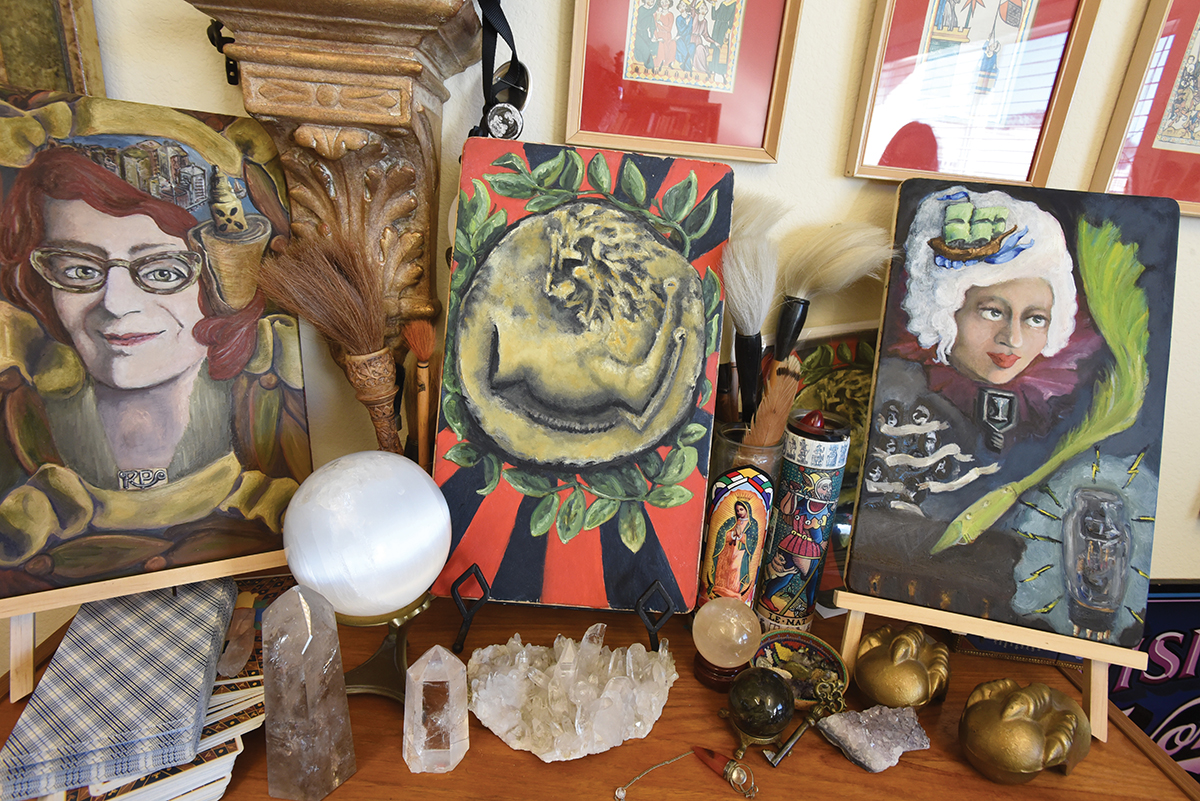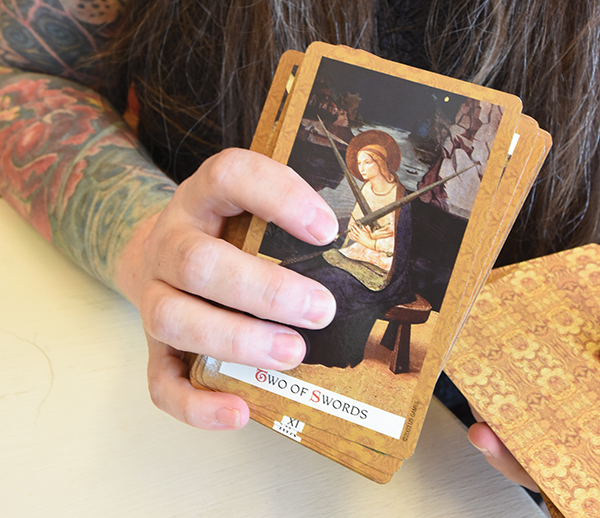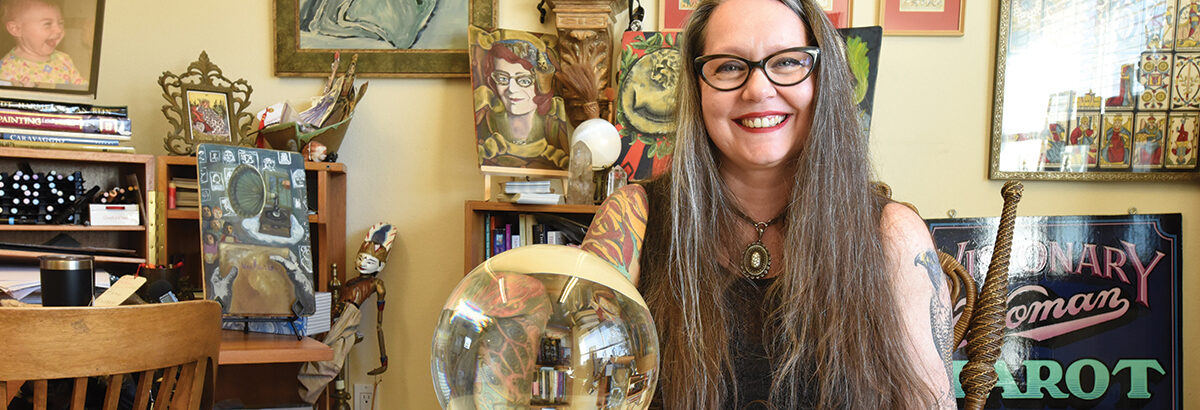Kristine Gorman reads the future and the past with paper cards.
story David Bolling
There’s a glass orb in the center of Kristine Gorman’s tarot table that has absolutely nothing to do with tarot, or anything else, except perhaps a little atmosphere.
Gorman says she got it at Plain Jane’s, the consignment shop, and she insists it’s just a fun prop. She does, however, have a gorgeous orb of selenite, a crystalized form of gypsum, in her reading room, that she calls “Nancy.”
“Nancy is a super slut. She just likes to be handled,” says Gorman, with a broad smile. “And it feels really good. You put it to your chest and it’s just so … I mean, it is the moon. Selenite is this lunar kind of thing.”
But we’re not here to talk about mineralized sluts, we’re here to talk tarot, the practice of using a specialized deck of cards to read the future, the past and all stops in between.
Most authorities trace tarot to medieval Italy and card decks called Trionfi.” The evolution of those decks — usually hand-painted in elaborate detail—led to the establishment of four suits and the concept of “trump” cards, “trionfi” in Italian, for “triumph,” an association now related to an American president.
Politics aside, tarot morphed from an elaborate card game into a form of divination, using 78 cards, that scholars believe only emerged in the 18th century, a time stamp that would deny occult roots in ancient Egypt, as some insist.
Whatever its past, Gorman isn’t concerned. “Tarot scholars from around the world have different opinions,” she says, “and so it gets kind of vague. Some people say Egypt, some people say Italy, some people say, ‘Well, as soon as there was paper, there were cards.’ So they’ve always been some kind of divination tool.”
Gorman, who also teaches tarot, practices it on the radio (KSVY, 91.3 FM) and appears at tarot festivals and conferences, describes herself as “a nurturing intuitive” who “interprets” clients at a “deeply empathic, interpersonal and emotional level.”

There are, to be sure, “academic types” who are “really well versed in symbology and history, and it’s very academic. And I really appreciate the scholar-academic readers, because I’m the exact opposite.”
Gorman follows her senses, not a body of academic training. “There’s 78 images,” she explains. “They’re archetypal images, and I can read three different people with the same cards and have three different stories. Because I feel like everybody’s got a message, right? And so, this is just a tool, a way to help me choose the words that whoever’s sitting in front of me needs to hear.”
OK, but how do the cards actually work? Are they magic?
“They’re just paper, you know? There’s no magical qualities to this deck of cards. It’s interpretation, it’s a tool for me, it’s not a magical object.”
Gorman says she’s always had a certain sensitivity. “I’ve always been a truth teller, I always was able to see things, and I thought that was just regular. But that’s not a friend-maker, let me tell you.”
So her husband, the nationally recognized tattoo artist Shotsie Gorman, with whom she shares a studio/home, handed her a tarot deck. “He said, ‘Here, why don’t you try these?’ Because I just didn’t have a way to communicate what I could see in a way it would be positively received.”
Gorman says that moment changed her life. “I was not a good student in school, but as soon as I picked up these cards, it was like, ‘Whoa, this is easy, it falls right in place.’ I was just immediately interested. I’m an artist, so I live in this abstract kind of world where I can create images, and it’s very intuitive. So, having a bit of an anchor is good for me.”
And that anchor gave Gorman something to commit to. “I think that if you commit, and this is kind of where it turned the corner for me, you commit to what comes in, and you commit to having it, saying it out of your mouth the exact way you see it, then you’re there. This is not a religion. You don’t have to believe in anything for it to happen.”
Now 20 years into tarot reading, Gorman handles the cards with casual confidence, laying them down in groups of three and immediately responding with intuitive insights.
First, she has you shuffle the deck, and then she tells you what she sees. In my case, I didn’t bring any burning questions—no relationship issues, no existential fears, no quest for direction, meaning, or fulfillment. Just basic journalistic curiosity. That, and a slightly desperate desire to know who would win the 2020 presidential election and whether Sonoma Valley had a happy future.
Nevertheless, Gorman immediately told me, “I see you making peace and resolution with what your true responsibilities are, and how you do have to do what looks like a selfish thing. But you do have to be unavailable for certain things. So, that’s new, and that’s not rejection, abandonment, that’s saying, ‘I’m making a change.’ I think that there’s been years of you trying not to be selfish. Thinking, ‘Oh, this move would be selfish,’ or, ‘That move will be selfish.’ I think that you’re ready to adjust those things in a permanent way, and that’s exciting.”
So much for my future. What about Donald Trump’s?
“It’s almost not even about the presidency anymore,” she says, “but I find it hard to believe anybody being able to beat him right now. I’d be surprised if he didn’t win. There’re too many rigged circumstances, which is really funny to say because he’s always said that about others. I mean, if you see how he describes everybody, he’s describing himself very well.”
And, she adds, “I think that there are such amazing works that are going to be done after this whole debacle, and when the real story is out, what really happened, people are going to be shocked. And it’s all going to come out.”
Among Gorman’s intriguing tidbits is the observation that, “There’s problems with the family, and I think he’ll let his family down, he’ll totally throw them under the bus. I mean, the big ego prevails.”

Gorman says she also sees some sort of “global union that’s going to form, and the kids are going to push to do it, which is cool, because the kids are not to be trifled with. You’ve got Greta, you’ve got the kids from the Parkland, Florida, shooting. They’re not messing around. They’re not just sitting there with a sign. They’re holding people accountable.”
Which raises questions about the future of the planet itself. Can we save it?
“The planet needs advocates, and it will come,” she says. “They’re like little antibodies. That’s really what they are. It does seem like the earth is dehydrated. And as much as we talk about global warming and the ice melting, well, that’s about saltwater. The fresh water is the real need, right? So, the planet is really waiting for thinking people to do something. It’s intellectually dehydrated, spiritually dehydrated. And so that’s what it’s going to take for people to say, I am this. It sounds like a Disney movie, but I just think that people are going to rise up and say, “I am the consciousness. I am the advocate.”
The Gormans were firmly established in New Jersey when, says Kristine, it became clear that “we needed someplace to go to just shed. Shotsie said, ‘I’ve been kicking the same dirt around for a long time,’ so we sold everything and moved west.”
First that meant Sedona, Arizona, popularly known as the crystal capital of the known universe, but when they discovered Sonoma, and the perfect property on Highway 12 in the Springs, they felt like they had come home.
“I love it here. I’m able to paint right in the next room, I’m just back and forth in my nest, and it’s great. Who knows what the future holds, but right now I’m really enjoying this and I can do my work anywhere.”
Mixing painting with tarot inevitably led Gorman to the threshold of what could be her artistic masterpiece, her own, hand-painted tarot deck. She is in the process of creating each card on oversized wooden tablets, with unique archetypes based on her own perceptions and experiences, before having them printed as a book.

And that leads to the question of whether a tarot reader can read her own tarot cards. “I can,” she says, “but my questions have to be specific. Sometimes I’m too close to the situation, it just doesn’t come. But if I adjust my question, then it works. But it’s also a journey to get to the source of the issue that forms the question. That’s kind of my answer anyway.”
Gorman has one other method for reading herself, and she’s currently enthralled with it. “There’s an I-Ching app you can get on your phone now, and it is the coolest thing ever. If you ever need grounding and centering, it works so well, and it’s five bucks. Readers need readers, and that’s where I go. I know who I am, I know what my abilities are, but when I really need to consult somebody, it’s usually the I-Ching. It tells me exactly what I need to know. It laughs at me sometimes.”
Kristine Gorman reads tarot at the Tarot Art & Tattoo Gallery, 17977 Sonoma Highway, Sonoma Valley. Go to tarotarttattoo.com or call 707.938.3000.

